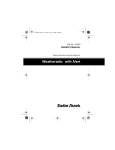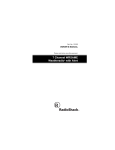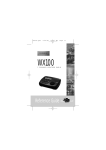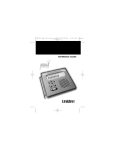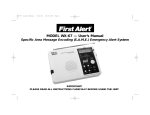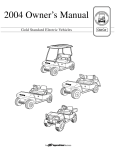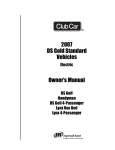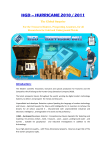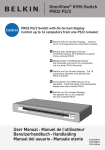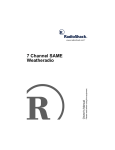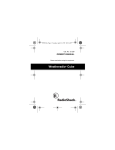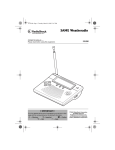Download Radio Shack 7-Channel Weatheradio Owner`s manual
Transcript
12-249.fm Page 1 Tuesday, July 6, 1999 4:00 PM Cat. No. 12-249 OWNER’S MANUAL Please read before using this equipment. 7-Channel Weatheradio with NWR-SAME Severe-Weather Alert 12-249.fm Page 2 Tuesday, July 6, 1999 4:00 PM WARNING: To reduce the risk of fire or shock hazard, do not expose this product to rain or moisture. CAUTION RISK OF ELECTRIC SHOCK. DO NOT OPEN. ! CAUTION: TO REDUCE THE RISK OF ELECTRIC SHOCK, DO NOT REMOVE COVER OR BACK. NO USER-SERVICEABLE PARTS INSIDE. REFER SERVICING TO QUALIFIED PERSONNEL. This symbol is intended to alert you to the presence of uninsulated dangerous voltage within the product’s enclosure that might be of sufficient magnitude to constitute a risk of electric shock. Do not open the product’s case. ! This symbol is intended to inform you that important operating and maintenance instructions are included in the literature accompanying this product. The graphical symbols with supplemental markings are on the bottom of the unit. © 1997, 1998 Tandy Corporation. All Rights Reserved. RadioShack and Weatheradio are registered trademarks used by Tandy Corporation. X-10 is a registered trademark of X-10 (USA) Inc. 2 12-249.fm Page 3 Tuesday, July 6, 1999 4:00 PM FEATURES In 1994, the National Oceanic and Aerospace Administration (NOAA) began broadcasting coded emergency weather signals that identify the specific geographic area (such as a county) affected by an emergency. Until that time, such specific emergency weather information was sent in other ways (over land wire, for example) to other communication outlets (such as radio stations), then broadcast to the public on AM or FM radio frequencies or on TV. NOAA transmits the coded weather emergency signals using a technique called Specific Area Message Encoding, or SAME. Your RadioShack 7-Channel Weatheradio with NWR-SAME (National Weather Radio-SAME) Severe-Weather Alert is specially designed to receive these SAME transmissions. The Weatheradio’s SAME technology circuitry lets you program it with up to 15 predefined state/county codes and receive emergency weather alert broadcasts that notify you of weather warnings, watches, statements — about 30 different types — for only those areas. You can set the Weatheradio to sound an alert when it receives a SAME emergency signal, and you can adjust the alert volume. The Weatheradio also comes preprogrammed with the seven NOAA broadcast frequencies, so you can select the channel that is broadcast in your area and listen to general weather information 24 hours a day. 3 12-249.fm Page 4 Tuesday, July 6, 1999 4:00 PM The Weatheradio’s features include: Alert Function — lets you set the Weatheradio to sound an alert when it receives a weather emergency broadcast from NOAA. SAME Operation — lets you program up to 15 different FIPS (Federal Information Processing System) codes into the Weatheradio’s memory. Each FIPS code identifies a specific geographic area (defined by the NWS), so your Weatheradio sounds an alert when a weather emergency is declared in only those locations. This helps you track the weather conditions in and around your area. 8-Character Liquid Crystal Display — clearly displays as digital characters items such as channel numbers and alert status descriptions (TORNADO WARNING, FLOOD WATCH, and so on). Alert Status Indicators — different-colored indicators let you determine at a glance the type of alert received (red is for a warning, yellow is for a watch, and green is for a statement). 7 Channels — let you select the frequency for your local NOAA weather broadcasts. 4 12-249.fm Page 5 Tuesday, July 6, 1999 4:00 PM Adjustable Display Backlight — makes the display easy to read in low light situations. You can set the light to turn on for about 10 seconds when you press a key, or remain on until you turn it off. Alert Volume Control — lets you adjust the volume of the alert so you will be sure to hear it. External Alert Terminals — let you connect an external controller system (such as a Plug ’n Power or X-10 system) to the Weatheradio and set that system to indicate an alert based on signals received by the Weatheradio. This is useful for ensuring you can hear or see the alert in a location (such as the garage) that might be some distance from where you installed the Weatheradio. External Antenna Connector — lets you connect an optional external antenna to the Weatheradio to improve reception (in remote areas, for example). We recommend you record your Weatheradio’s serial number here. The number is on the bottom of the radio. Serial Number: 5 12-249.fm Page 6 Tuesday, July 6, 1999 4:00 PM CONTENTS Preparation ...................................................................... 7 Connecting Power ..................................................... 7 Connecting AC Power ....................................... 8 Installing a Back-Up Battery .............................. 9 Using the Antenna ................................................... 11 Connecting an External Antenna .................... 11 Getting Started .............................................................. Understanding the FIPS Code ................................ Obtaining Your Area’s FIPS Code(s) ............... Programming the Weatheradio ............................... Using the Weatheradio’s “All Signals” Code ................................................. Choosing a Location and Mounting the Weatheradio .............................................. 12 12 13 14 Operation ....................................................................... Listening to the Weather Broadcast ........................ Using the Alert Function .......................................... Setting the Alert Volume .................................. Checking/Changing the Alert Pattern .............. When a Weather Alert Occurs ........................ NWS Weather Alert Descriptions .................... Reviewing Overlapping Alerts ......................... When a Test or Demo Alert Occurs ................. Locking Out Undefined (New or Commercial) Weather Descriptions ...................................... 22 23 24 25 25 27 28 32 33 19 20 34 Special Features ............................................................ 37 Using Continuous Backlight .................................... 37 Connecting the Weatheradio to an External System ...................................................... 38 Troubleshooting ............................................................ 40 Care ................................................................................ 44 The FCC Wants You to Know .................................. 46 Specifications ................................................................ 47 6 12-249.fm Page 7 Tuesday, July 6, 1999 4:00 PM PREPARATION CONNECTING POWER Your Weatheradio uses standard AC power for normal operation. For back-up power (when AC power fails or is temporarily disconnected), your Weatheradio requires a 9V battery (not supplied). For the best performance and longest life, we recommend an alkaline battery, such as RadioShack Cat. No. 23-553. Notes: • A fresh back-up battery will power the Weatheradio for up to 1 hour with the weather broadcast turned on (see “Listening to the Weather Broadcast” on Page 23) or up to 8 hours in alert standby mode (see “Using the Alert Function” on Page 24). For normal use, however, we recommend you always connect the Weatheradio to AC power. • If you disconnect the Weatheradio from AC power and you will not be using the Weatheradio for several days, remove the back-up battery. A battery can leak chemicals that damage your Weatheradio’s electronic parts. 7 12-249.fm Page 8 Tuesday, July 6, 1999 4:00 PM Connecting AC Power 1. If the Weatheradio is on, turn VOLUME to the right until it clicks to turn the Weatheradio off. VOLUME OFF MAX 2. Plug the Weatheradio’s power cord into a standard AC outlet. Caution: Your Weatheradio’s power cord has a polarized plug (one blade is wider than the other). If you have difficulty inserting the plug into the outlet, do not force it! Turn the plug over and try again. 8 12-249.fm Page 9 Tuesday, July 6, 1999 4:00 PM Installing a Back-Up Battery Cautions: • Use only a fresh battery of the required size and recommended type. • We recommend you not use a rechargeable battery. Tab 1. If the Weatheradio is on, turn VOLUME to the right until it clicks to turn the Weatheradio off. 2. Press in the tab on the battery compartment cover and lift the cover up to remove it. 3. Snap a battery onto the battery terminals inside the compartment, then put the battery in the compartment. 4. Replace the cover. 9 12-249.fm Page 10 Tuesday, July 6, 1999 4:00 PM When REPLACE (then) BATTERY appears, replace the battery. STATEMENT WATCH ALERT LEVEL WARNING STATEMENT WATCH WARNING ALERT LEVEL Note: REPLACE BATTERY also appears if no battery is installed and the Weatheradio is turned on and connected to AC power. Caution: Never leave a dead or weak battery in the Weatheradio. Dispose of an old battery promptly and properly; do not bury or burn it. 10 12-249.fm Page 11 Tuesday, July 6, 1999 4:00 PM USING THE ANTENNA For the best reception at all times, lift up the Weatheradio’s built-in telescoping antenna so it is vertical, then fully extend it. OPERATE PROGRAM MODE + – EXT ANT ALARM OUT Connecting an External Antenna To improve reception (in remote areas, for example), you can connect an external antenna using an adapter cable (RadioShack Unlimited Cat. No. 11806437, not supplied) with a phono plug to the Weatheradio’s EXT ANT jack. Your local RadioShack store sells a wide variety of antennas. To connect an external antenna to the Weatheradio, connect one end of the adapter cable to EXT ANT on the Weatheradio and connect the other end to the phono plug on the antenna. Then lower the Weatheradio’s telescoping antenna. OPERATE PROGRAM MODE + – EXT ANT ALARM OUT 11 12-249.fm Page 12 Tuesday, July 6, 1999 4:00 PM GETTING STARTED UNDERSTANDING THE FIPS CODE The NWS divides the United States by state and county (or parish, where applicable), then assigns a 6-digit “FIPS” (Federal Information Processing System) code to identify each county/parish for the purpose of broadcasting weather conditions. For example, the code for Tarrant County, Texas, is 048439. The first digit in a FIPS code identifies the county subdivision, the next two digits identify the state, and the last three digits identify the county itself. For example: State 048439 County County Subdivision Note: Most FIPS codes begin with 0, which means that FIPS code represents an entire county. The NWS, however, eventually plans to subdivide some large counties. When that happens, each subdivision will be assigned a digit from 1–9, resulting in codes such as 148439, 248439, and so on. Your Weatheradio is preset to receive all SAME alert signals broadcast within about a 50-mile radius of where you installed it. To receive SAME alerts and broadcasts about weather occurring only in particular counties within that area, you can program up to 15 12 12-249.fm Page 13 Tuesday, July 6, 1999 4:00 PM FIPS codes into the Weatheradio’s memory. That way, for example, you can avoid an alert that applies to an area within that 50-mile radius but not in your county. Obtaining Your Area’s FIPS Code(s) To obtain the FIPS code for the location where you installed the Weatheradio, contact your local RadioShack store or call the NWS toll free at: 1-888-NWR-SAME (1-888-697-7263) If you call the NWS, follow the instructions you hear. Note: If you are close to a county/parish line(s), you might want to obtain the codes for any other counties/ parishes you are close to. Hint: Since you can program up to 15 FIPS codes into the Weatheradio’s memory, you might want to obtain the codes for other local areas that you travel through to work (as long as those areas are within a 50 mile radius of your location and within an area covered by your local NWS broadcast station). That way, you can program those codes into the Weatheradio and receive broadcasts covering those locations, too. 13 12-249.fm Page 14 Tuesday, July 6, 1999 4:00 PM PROGRAMMING THE WEATHERADIO Note: Some of the Weatheradio’s keys (such as 0–9) are located under the cover on top of the Weatheradio. Lift the cover to access the keys. The first time you use your Weatheradio, it is automatically set to: • Use the NOAA weather broadcast frequency 162.400 MHz (Channel 1) • Receive all SAME alert signals broadcast within a 50-mile radius of where you installed it Your Weatheradio is preprogrammed with the seven national NOAA broadcast frequencies (Channels 1– 7). Depending on your location, you might need to select a different channel. To select a different broadcast frequency (if necessary) and store or change FIPS codes in the Weatheradio’s memory (to narrow the area in which you receive SAME alerts), follow these steps. 14 12-249.fm Page 15 Tuesday, July 6, 1999 4:00 PM 1. To turn on the Weatheradio, turn VOLUME to the left until it clicks. Then set SINGLE/MULTIPLE (on the bottom of the radio) to SINGLE if you are entering only one FIPS code or to MULTIPLE if you are entering more than one. 2. Set PROGRAM/OPERATE to PROGRAM. The Weatheradio displays the last selected weather broadcast channel and frequency number. OPERATE PROGRAM MODE + – EXT ANT ALARM OUT 3. Press WEATHER to turn on the weather broadcast (if necessary), then turn VOLUME to adjust the volume so you can hear the broadcast as you make your selection. OFF WEATHER ALERT VOLUME OFF MAX 15 12-249.fm Page 16 Tuesday, July 6, 1999 4:00 PM Note: If you do not press a key for about 45 seconds during Steps 4–8, the Weatheradio exits the programming mode, and saves only those changes stored before the last keypress. To continue, set PROGRAM/OPERATE back to OPERATE, then start over at Step 2. 4. Press a number key (1–7) to listen to the broadcast on that channel. The Weatheradio displays the selected channel and its corresponding frequency. Repeat this step until you find the channel broadcasting in your area. Channel Frequency (MHz) 1 162.400 2 162.425 3 162.450 4 162.475 5 162.500 6 162.525 7 162.550 Note: If you receive a NOAA broadcast on more than one channel, the one with the best reception might not be the one broadcasting information for your location. Contact your local RadioShack store or NWS office to find out which frequency NOAA is using to broadcast from the station nearest your location, then select that channel. 16 12-249.fm Page 17 Tuesday, July 6, 1999 4:00 PM 5. Press YES three times. The Weatheradio displays the FIPS code stored in the first memory position. 6 4 5 7 8 9 0 NO YES OFF WEATHER ALERT VOLUME STATEMENT WATCH WARNING OFF MAX ALERT LEVEL 6. To change the code in the first memory position, press YES so ------ appears. STATEMENT WATCH WARNING ALERT LEVEL To add or change a code in a different position, repeatedly press NO until you see the first unused memory position or the code you want to change, then press YES so ------ appears. 7. Use the number keys (0–9) to enter the 6-digit FIPS code you want to store. Notes: • If you make a mistake while entering the code, press NO to clear all digits (so ------ reappears), then enter the correct digits. 17 12-249.fm Page 18 Tuesday, July 6, 1999 4:00 PM • To reset the Weatheradio to receive all SAME signals within a 50-mile radius, simply enter the code 99 in the first memory position. See “Using the Weatheradio’s ‘All Signals’ Code” on Page 19. • For easy reference, write down each FIPS code you store in memory on the label located beneath the Weatheradio’s keypad cover. 8. Press YES to store the code in the Weatheradio’s memory. If you set SINGLE/MULTIPLE to MULTIPLE, the code (if any) stored in the next memory position appears on the display. Repeat Steps 4–6 for each code (up to 15) you want to change or add. When you press YES to store a code in the last (15th) memory position, the code you stored in the first position reappears. If you set SINGLE/MULTIPLE to SINGLE, the display does not change. 9. When you finish, set PROGRAM/OPERATE to OPERATE. The current alert status appears (see “Using the Alert Function” on Page 24). 18 12-249.fm Page 19 Tuesday, July 6, 1999 4:00 PM Important: The fact that you get clear reception of a weather broadcast signal does not guarantee that an emergency alert broadcast will trigger your Weatheradio’s alert function. Be sure you choose the proper location for the Weatheradio (see “Choosing a Location and Mounting the Weatheradio” on Page 20) and regularly check the Weatheradio to be sure it is operating properly (see “When a Test or Demo Alert Occurs” on Page 33). Using the Weatheradio’s “All Signals” Code This Weatheradio is preset to use a default “all signals” code of 99, which lets it receive all SAME broadcasts within a 50-mile radius. (This code is unique to your Weatheradio — it is not a FIPS code.) The first time you program the Weatheradio, you replace the “all signals” code (in the first memory position) with a specific NWS FIPS code. To reset the Weatheradio to use the “all signals” code again, simply follow Steps 1, 2, and 5–9 in “Programming the Weatheradio” on Page 14, and store 99 in the first memory position in Step 6. 19 12-249.fm Page 20 Tuesday, July 6, 1999 4:00 PM CHOOSING A LOCATION AND MOUNTING THE WEATHERADIO You can set your Weatheradio on any flat surface (such as a shelf or counter top), or you can mount it on a wall using the supplied mounting bracket and two screws (not supplied) with heads that fit the keyhole slots on the mounting bracket. For your Weatheradio to be effective, however, be sure you place the Weatheradio where: • It can receive alert signals (see “When a Test or Demo Alert Occurs” on Page 33) • You can hear its alert tone (see “Setting the Alert Volume” on Page 25) Note: You can also connect the Weatheradio to an external module interface, then set the interface to indicate an alert (sound a buzzer or flash a light, for example) on a connected appliance when the Weatheradio receives an emergency alert broadcast. See “Connecting the Weatheradio to an External System” on Page 38. 20 12-249.fm Page 21 Tuesday, July 6, 1999 4:00 PM Follow these steps to mount the Weatheradio on a wall. 1. Select a mounting location near the AC outlet, then drill two holes 21/8 inches apart. Then thread a screw into each mounting hole until the head extends about 1/8 inch from the wall. Cutouts 8H O DI A CA T. FR NO EQ 4-1 UE. 12 -24 PO 62.47 NC 9 NE T TO ER AL SING LE MU LT IPLE SER IAL NO. R LISTE D 12 Cu WE 5M Y : 1-1 R ® of stom SU Hz 62 Ta PP 5-1 .40 nd Ma LY 62 0M y Co nu : .50 Hz fac AC rpo tur 12 0MHz 2-1 62 FC rat ed 0V ion in 60 6-1 .42 C ID: Ch Hz 62 5M , ® Fo ina 5W .52 Hz AA 5M O1 rt Wo for Hz 3-1 2-2 rth Ra 7-1 62.45 49 , Te dio 62 0M .55 Hz xa Sh s 76 ac 0M k, Hz 10 A 2 Div isio n 2. Insert the tabs on the bracket into the slots on the Weatheradio. Then, while making sure any connected cords (power and so on) are aligned with the cutouts in the bracket, press the bracket toward the Weatheradio until it clicks into place. 3. Align the keyhole slots in the mounting bracket with the screws on the wallPress the weatheradio toward the wall then down to secure it. 21 12-249.fm Page 22 Tuesday, July 6, 1999 4:00 PM OPERATION To turn on the Weatheradio, turn VOLUME to the left until it clicks. WEATHER (then) ALRT (alert) ON appears. OFF WEATHER ALERT VOLUME STATEMENT WATCH WARNING OFF MAX ALERT LEVEL Note: VOLUME also controls the Weatheradio’s audio broadcast volume. To set the alert volume, see “Setting the Alert Volume” on Page 25. To listen to the weather broadcast, see “Listening to the Weather Broadcast” on Page 23. To have the Weatheradio sound an alert, see “Using the Alert Function” on Page 24. To turn off the Weatheradio, turn VOLUME to the right until it clicks and the display goes blank. 22 12-249.fm Page 23 Tuesday, July 6, 1999 4:00 PM LISTENING TO THE WEATHER BROADCAST Your Weatheradio is preprogrammed with the seven NOAA weather broadcast frequencies (Channels 1– 7). To select the frequency broadcast in your area (if you did not do so already), follow Steps 2–4 and 9 in “Programming the Weatheradio” on Page 14. To listen to the weather broadcast, be sure OPERATE/ PROGRAM is set to OPERATE, press WEATHER, then adjust VOLUME to the desired listening level. To turn off the weather broadcast, press WEATHER again. OFF WEATHER ALERT VOLUME STATEMENT WATCH WARNING OFF MAX ALERT LEVEL 23 12-249.fm Page 24 Tuesday, July 6, 1999 4:00 PM USING THE ALERT FUNCTION To set the Weatheradio to sound an alert when the NWS broadcasts a weather warning, watch, or statement for the FIPS code(s) stored in its memory, press ALERT so WEATHER (then) ALRT ON appears. OFF WEATHER ALERT VOLUME STATEMENT WATCH WARNING OFF MAX ALERT LEVEL Notes: • If you programmed more than one FIPS code into memory, be sure SINGLE/MULTIPLE is set to MULTIPLE. Otherwise, the Weatheradio will only receive broadcasts for the FIPS code you stored in the first memory position. • If severe weather threatens, do not wait for an alert tone; turn on the weather broadcast and monitor the weather information. To set the Weatheradio so it does not sound an alert, press ALERT again so WEATHER ALRT OFF appears. 24 12-249.fm Page 25 Tuesday, July 6, 1999 4:00 PM Setting the Alert Volume To set your Weatheradio’s alert volume, use a coin to turn ALERT TONE clockwise to increase the volume or counterclockwise to decrease it. To begin (before you hear the alert the first time), we recommend you select the highest volume setting, then decrease it as needed. Changing/Checking the Alert Pattern You can set the Weatheradio to respond to an NWS alert broadcast in one of two ways. VOICE — the Weatheradio sounds an alert for about 8 seconds, then automatically turns on the weather (voice) broadcast for 5 minutes. Then it returns to standby mode. It also displays the alert description (such as TORNADO WARNING) until the alert’s effective time (such as 2 hours, 30 minutes; received as part of the NWS broadcast code) expires. 25 12-249.fm Page 26 Tuesday, July 6, 1999 4:00 PM (Continuous) ALERT — the Weatheradio sounds an alert and displays an alert description until the alert’s effective time expires. The Weatheradio automatically selects the VOICE setting the first time you turn it on. To change the alert pattern setting (or check which setting is currently selected), follow these steps. 1. Set PROGRAM/OPERATE to PROGRAM. Note: If you do not press a key for about 45 seconds during Steps 2–4, the Weatheradio exits the programming mode without storing any change. To continue, set PROGRAM/OPERATE back to OPERATE, then start over at Step 1. 2. Press YES once. The Weatheradio shows the currently selected alert pattern (VOICE or ALERT). 6 4 5 7 8 9 0 NO YES OFF WEATHER ALERT VOLUME STATEMENT WATCH WARNING OFF MAX ALERT LEVEL 3. To select the other setting, press NO so that setting (VOICE or ALERT) appears. 4. Press YES again to store your selection, then set PROGRAM/OPERATE to OPERATE. The current alert status appears. 26 12-249.fm Page 27 Tuesday, July 6, 1999 4:00 PM When a Weather Alert Occurs When WEATHER ALRT ON shows on the display and the Weatheradio receives a broadcast for the FIPS code(s) stored in its memory, the Weatheradio sounds an alert (siren or beep), displays the alert description, and turns on the corresponding colored indicator (WARNING/red, WATCH/yellow, or STATEMENT/green). The alert descriptions are based on a list of specific weather alert types published by the NWS. For a list of all the alert descriptions that your Weatheradio can display, see “NWS Weather Alert Descriptions” on Page 28. If you selected the VOICE pattern, the Weatheradio sounds an alert for about 8 seconds, then automatically turns on the weather (voice) broadcast for 5 minutes. Then it returns to standby mode. It also displays the alert description until the alert’s effective time expires. To turn off the alert sooner, press OFF. Note: When the Weatheradio’s alert ends or you turn it off, you will hear the NWS alert tone (which sounds different than the Weatheradio’s tone) for a few seconds before you hear the voice broadcast. If you selected the ALERT pattern, the Weatheradio sounds an alert and displays the alert description for the alert’s effective time. To turn off the alert sooner, press OFF. To turn on the NWS voice broadcast, press WEATHER. 27 12-249.fm Page 28 Tuesday, July 6, 1999 4:00 PM Caution: The NWS uses sophisticated weather models to determine an alert’s effective time. However, if a storm front (for example) moves through an area at a slower speed than initially predicted, the stormrelated activity might continue after the alert ends. The end of an alert does not necessarily mean that the related weather emergency is over. NWS Weather Alert Descriptions Your Weatheradio can display these NWS weather alert descriptions. For easy reference, this list also shows the type of alert (siren or beep) that sounds during each alert. You See 28 Weather/Alert Description You Hear TORNADO WATCH Tornado watch Siren TORNADO WARNING Tornado warning Siren SEVERE THUNDER WATCH Severe thunderstorm watch Siren SEVERE THUNDER WARNING Severe thunderstorm warning Siren 12-249.fm Page 29 Tuesday, July 6, 1999 4:00 PM You See Weather/Alert Description You Hear SEVERE WEATHER Severe weather statement Beeps SPECIAL WEATHER Special weather statement Beeps Flash flood watch Siren Flash flood warning Siren FLASH FLOOD Flash flood statement Beeps FLOOD WATCH Flood watch Siren Flood warning Siren Flood statement Beeps Winter storm watch Siren Winter storm warning Siren FLASH FLOOD WATCH FLASH FLOOD WARNING FLOOD WARNING FLOOD WINTER STORM WATCH WINTER STORM WARNING 29 12-249.fm Page 30 Tuesday, July 6, 1999 4:00 PM You See 30 Weather/Alert Description You Hear BLIZZARD WARNING Blizzard warning Siren HIGHWIND WATCH High wind watch Siren HIGHWIND WARNING High wind warning Siren HURRICAN WATCH Hurricane watch Siren HURRICAN WARNING Hurricane warning Siren HURRICAN Hurricane statement Beeps NUCLEAR ATTACK WARNING Nuclear attack warning Siren TSUNAMI WATCH Tsunami watch Siren TSUNAMI WARNING Tsunami warning Siren TUNE TV Civil emergency — turn on the TV for information or, if no information is available on TV, call your local NWS office Siren 12-249.fm Page 31 Tuesday, July 6, 1999 4:00 PM You See Weather/Alert Description You Hear Note: The alert description TUNE TV could also indicate the Weatheradio has received a signal for a condition not defined in the Weatheradio’s memory — see “Locking Out Undefined (New or Commercial) Weather Descriptions” on Page 34. SEVERE MARINE WARNING Severe marine warning Siren EVACUATE IMMEDIAT Evacuate immediately Siren EMERGENC ACTION WARNING Emergency action warning Siren Coastal flood warning Siren COASTAL FLOOD WARNING 31 12-249.fm Page 32 Tuesday, July 6, 1999 4:00 PM Reviewing Overlapping Alerts Your Weatheradio can store up to three different alerts (with overlapping effective times) in its memory. If the Weatheradio receives a new alert while a previous alert is still in effect, it automatically displays the alert description and sounds an alert for the new alert. To scroll forward or backward through the Weatheradio’s memory and review all effective alerts, press NO (to scroll forward) or YES (to scroll backward). Notes: • The Weatheradio sounds a high-pitched keytone if you try to scroll past the first or last alert in memory. To continue, press the other key to begin scrolling in the opposite direction. • If the Weatheradio receives a new alert while three previous alerts are still in effect, it stores the new alert and clears the oldest alert from memory. 32 12-249.fm Page 33 Tuesday, July 6, 1999 4:00 PM When a Test or Demo Alert Occurs The NWS sends out daily and weekly test (and sometimes demonstration) signals, which let anyone with a receiver, such as your Weatheradio, verify that the equipment is working properly. To find out the specific test schedule in your area, contact your local NOAA or NWS office. Those offices are usually listed in the telephone book under US Government, Department of Commerce. When the Weatheradio’s alert function is turned on and the Weatheradio receives a test broadcast for a FIPS code you programmed into its memory, it responds in one of these ways: NWS Alert Type You See You Hear Daily Test or Demo Test No sound Required Weekly or Monthly SAME Test Test Beeps Note: The Weatheradio does not turn on an indicator (WARNING, WATCH, or STATEMENT) during a test/ demo broadcast. If your Weatheradio is turned on and properly set, but it does not respond to a test broadcast, see “Troubleshooting” on Page 40. 33 12-249.fm Page 34 Tuesday, July 6, 1999 4:00 PM Locking Out Undefined (New or Commercial) Weather Descriptions The NWS might occasionally broadcast several types of weather information intended for commercial or other non-private use. This information could include, for example, messages intended for automated weather services (such as those used by radio or TV stations). Your Weatheradio’s memory does not contain a specific, corresponding description for the signals related to these commercial weather types. Additionally, your Weatheradio is designed to recognize all common weather alert types currently used by the NWS. The NWS could, however, eventually create and broadcast new alert types (for which the Weatheradio’s memory does not contain a specific, corresponding description). If your Weatheradio receives a signal for a new alert type, it is preset (if the alert function is turned on) to display the alert description TUNE TV and sound a siren alert. It is not set to alert you when it receives a commercial alert type. Depending on your preference, you can follow these steps to change the way the Weatheradio responds to new or commercial weather alert broadcasts. 34 12-249.fm Page 35 Tuesday, July 6, 1999 4:00 PM 1. Turn VOLUME toward off until it clicks to turn off the Weatheradio. 2. While holding down OFF, turn VOLUME to the left until it clicks to turn on the Weatheradio. TESTMODE appears and all colored indicators turn on. YES OFF 0 WEATHER NO ALERT VOLUME STATEMENT WATCH WARNING OFF MAX ALERT LEVEL 3. Press a number key to select the desired setting. The Weatheradio sounds a beep. You Press: To Set the Weatheradio to: 0 (default) For new alert type: sound siren For commercial alert type: no response 8 For new alert type: no response For commercial type: no response (see “Important” on Page 36) 9 For new alert type: sound siren For commercial alert type: sound beeps 35 12-249.fm Page 36 Tuesday, July 6, 1999 4:00 PM Important: To ensure your Weatheradio is always set to notify you of a valid emergency, we recommend you do not select the setting (8) that causes the Weatheradio to not respond to new weather alert types. Note: Your Weatheradio can also perform these functions while TESTMODE appears: • If you press a key from 1–7, you hear the weather broadcast (if any) on that channel (see “Programming the Weatheradio” on Page 14). This does not affect the weather broadcast setting you selected during programming. • If you press ALERT, the Weatheradio continuously sounds its alert siren. Press ALERT again to turn off the siren. • If you press WEATHER, all display characters appear at the same time. 4. Turn VOLUME toward off until it clicks to turn off the Weatheradio and store your selection. Then turn it back on to begin using the new setting. 36 12-249.fm Page 37 Tuesday, July 6, 1999 4:00 PM SPECIAL FEATURES USING CONTINUOUS BACKLIGHT Your Weatheradio is preset to turn on its display backlight while you listen to the weather broadcast (see “Listening to the Weather Broadcast” on Page 23), and for about 10 seconds each time you press a key. For extended use in low light situations, you can set the backlight so it remains on until you turn it off. To turn the backlight on or off, follow these steps. 1. Set PROGRAM/OPERATE to PROGRAM. 2. Within 45 seconds, press YES twice so CONTINUO (continuous) and BACKLITE alternately flash on the display, then press YES to turn on continuous backlight or NO to turn it off. STATEMENT WATCH ALERT LEVEL WARNING STATEMENT WATCH WARNING ALERT LEVEL Note: If you do not press a key for about 45 seconds, the Weatheradio automatically exits the programming mode. Set PROGRAM/OPERATE back to OPERATE, then start over at Step 1. 3. Set PROGRAM/OPERATE to OPERATE. 37 12-249.fm Page 38 Tuesday, July 6, 1999 4:00 PM CONNECTING THE WEATHERADIO TO AN EXTERNAL SYSTEM Your Weatheradio’s ALARM OUT jacks let you connect it to an external module interface (Plug ’n Power or X-10, such as RSU 10037745) using twin-lead 20gauge cable (not supplied), then set the interface to indicate an alert (sound a buzzer or flash a light, for example) on a connected appliance when the Weatheradio receives a weather emergency alert broadcast. Note: Your local RadioShack store carries a wide selection of cable and audible or visible alert accessories you can use with the recommended external module interface. To connect your Weatheradio to an external system, connect the Weatheradio’s positive (+) and negative (–) ALARM OUT quick-connect terminals to the corresponding (+ and –) terminals on the external system. OPERATE PROGRAM MODE 38 + – ALARM OUT EXT ANT 12-249.fm Page 39 Tuesday, July 6, 1999 4:00 PM When the Weatheradio’s alert function is turned on and it receives an NWS alert broadcast, the Weatheradio sends 7.5VDC signals to the connected module interface, and an alert sounds on both the Weatheradio and the connected system. Note: For instructions on operating the external module interface, see the owner’s manual provided with that system. 39 12-249.fm Page 40 Tuesday, July 6, 1999 4:00 PM TROUBLESHOOTING If your Weatheradio is not working as it should, these suggestions might help you eliminate the problem. If it still does not operate normally, take it to your local RadioShack store for assistance. Problem(s) No power. Suggestion(s) Ensure the Weatheradio is properly connected to AC power, and that a fresh back-up battery is installed (if AC power has failed). See “Connecting Power” on Page 7. No sound. Adjust VOLUME or ALERT TONE. See “Operation” on Page 22 or “Setting the Alert Volume” on Page 25. Multiple FIPS codes are stored in memory, but the radio only responds to the weather alert broadcasts for one code. 40 Ensure SINGLE/MULTIPLE is set to MULTIPLE. 12-249.fm Page 41 Tuesday, July 6, 1999 4:00 PM Problem(s) No weather broadcast when you press WEATHER. Suggestion(s) Ensure that the telescoping antenna is fully extended. See “Using the Antenna” on Page 11. If you connected an external antenna, ensure that it is connected properly and the telescoping antenna is lowered. See “Connecting an External Antenna” on Page 11. Ensure the Weatheradio is set to the NOAA channel that is being broadcast in your area. See “Programming the Weatheradio” on Page 14 One or more FIPS codes are stored in memory, but the radio responds to weather alert broadcasts for areas not covered by those codes. Ensure the Weatheradio’s all-signals code (99) is not stored in memory. See “Using the Weatheradio’s ‘All Signals’ Code” on Page 19. 41 12-249.fm Page 42 Tuesday, July 6, 1999 4:00 PM Problem(s) The radio is not responding properly to NWS weather alert broadcasts. Suggestion(s) Ensure you programmed the correct FIPS code(s) into the Weatheradio’s memory. See “Programming the Weatheradio” on Page 14. Ensure the display shows WEATHER ALRT ON. If not, press ALERT. See “Using the Alert Function” on Page 24. Ensure PROGRAM/OPERATE is set to OPERATE. Ensure the Weatheradio is set to receive new alert types. See “Locking Out Undefined (New or Commercial) Weather Descriptions” on Page 34. 42 12-249.fm Page 43 Tuesday, July 6, 1999 4:00 PM Problem(s) CHECK OP (check operation) appears. Suggestion(s) The Weatheradio has not received any type of SAME alert signal (including test or demo signals) for about one week. Ensure the FIPS code(s) stored in memory are valid/correct. See “Programming the Weatheradio” on Page 14. Ensure the telescoping antenna is fully extended or the external antenna (if any) is properly connected. See “Using the Antenna” on Page 11. The Weatheradio’s continuous alert tone sounds intermittent or seems to warble. The Weatheradio constantly monitors the channel you set it to, even while it is sounding a continuous alert. Each time the Weatheradio receives a signal on that channel, it pauses very briefly to compare that signal against those stored in its memory. If the Weatheradio pauses frequently (depending on how often it receives a signal), it might make the Weatheradio’s continuous alert tone sound intermittent. This is not a malfunction. 43 12-249.fm Page 44 Tuesday, July 6, 1999 4:00 PM CARE Your RadioShack 7-Channel Weatheradio with NWR-SAME Severe-Weather Alert is an example of superior design and craftsmanship. The following suggestions will help you care for your Weatheradio so you can enjoy it for years. Keep the Weatheradio dry. If it gets wet, wipe it dry immediately. Liquids might contain minerals that can corrode the electronic circuits. Use and store the Weatheradio only in normal temperature environments. Temperature extremes can shorten the life of electronic devices, damage the batteries, and distort or melt plastic parts. Keep the Weatheradio away from dust and dirt, which can cause premature wear of parts. Handle the Weatheradio gently and carefully. Dropping it can damage circuit boards and cases and can cause the Weatheradio to work improperly. 44 12-249.fm Page 45 Tuesday, July 6, 1999 4:00 PM Use only a fresh battery of the required size and recommended type. A battery can leak chemicals that damage your Weatheradio’s electronic parts. Wipe the Weatheradio with a damp cloth occasionally to keep it looking new. Do not use harsh chemicals, cleaning solvents, or strong detergents to clean the Weatheradio. Modifying or tampering with the Weatheradio’s internal components can cause a malfunction, invalidate its warranty, and void your FCC authorization to operate it. If your Weatheradio is not performing as it should, take it to your local RadioShack store for assistance. 45 12-249.fm Page 46 Tuesday, July 6, 1999 4:00 PM THE FCC WANTS YOU TO KNOW Your Weatheradio might cause TV or radio interference even when it is operating properly. To determine whether your Weatheradio is causing the interference, turn off your Weatheradio. If the interference goes away, your Weatheradio is causing it. Try to eliminate the interference by: • Moving your Weatheradio away from the TV or radio • Contacting your local RadioShack store for help 46 12-249.fm Page 47 Tuesday, July 6, 1999 4:00 PM SPECIFICATIONS Frequency Coverage (MHz): Channel 1 .................................................. 162.400 Channel 2 ................................................. 162.425 Channel 3 ................................................. 162.450 Channel 4 ................................................. 162.475 Channel 5 ................................................. 162.500 Channel 6 ................................................. 162.525 Channel 7 ................................................. 162.550 Receiving Sensitivity (at 12 dB SINAD)................ 0.3 µV FIPS Code Sensitivity @ ± kHz Deviation/90% Success Rate ............. 0.25 µV Signal to Noise Ratio ............................................ 40 dB Dual Tone Detection Range ..................... 1.2 to 2.4 kHz Channel Selectivity .............................. ± 25 kHZ, 60 dB Power Output (Maximum) ................................. 250 mW Power Supply .................. 120 Volts, 60 Hz, 5 Watts AC Battery Back-up ................................ One 9-Volt Battery (Cat. No. 23-553) Antenna ................................ Telescoping Rod Antenna Dimensions (HWD) ........................ 53/16 × 63/4 × 13/16 in (13.15 × 17.15 × 2.99 cm) Weight .............................................................. 17.67 oz (501 g) Specifications are typical; individual units might vary. Specifications are subject to change and improvement without notice. 47 12-249.fm Page 48 Tuesday, July 6, 1999 4:00 PM Limited Ninety-Day Warranty This product is warranted by RadioShack against manufacturing defects in material and workmanship under normal use for ninety (90) days from the date of purchase from RadioShack company-owned stores and authorized RadioShack franchisees and dealers. EXCEPT AS PROVIDED HEREIN, RadioShack MAKES NO EXPRESS WARRANTIES AND ANY IMPLIED WARRANTIES, INCLUDING THOSE OF MERCHANTABILITY AND FITNESS FOR A PARTICULAR PURPOSE, ARE LIMITED IN DURATION TO THE DURATION OF THE WRITTEN LIMITED WARRANTIES CONTAINED HEREIN. EXCEPT AS PROVIDED HEREIN, RadioShack SHALL HAVE NO LIABILITY OR RESPONSIBILITY TO CUSTOMER OR ANY OTHER PERSON OR ENTITY WITH RESPECT TO ANY LIABILITY, LOSS OR DAMAGE CAUSED DIRECTLY OR INDIRECTLY BY USE OR PERFORMANCE OF THE PRODUCT OR ARISING OUT OF ANY BREACH OF THIS WARRANTY, INCLUDING, BUT NOT LIMITED TO, ANY DAMAGES RESULTING FROM INCONVENIENCE, LOSS OF TIME, DATA, PROPERTY, REVENUE, OR PROFIT OR ANY INDIRECT, SPECIAL, INCIDENTAL, OR CONSEQUENTIAL DAMAGES, EVEN IF RadioShack HAS BEEN ADVISED OF THE POSSIBILITY OF SUCH DAMAGES. Some states do not allow the limitations on how long an implied warranty lasts or the exclusion of incidental or consequential damages, so the above limitations or exclusions may not apply to you. In the event of a product defect during the warranty period, take the product and the RadioShack sales receipt as proof of purchase date to any RadioShack store. RadioShack will, at its option, unless otherwise provided by law: (a) correct the defect by product repair without charge for parts and labor; (b) replace the product with one of the same or similar design; or (c) refund the purchase price. All replaced parts and products, and products on which a refund is made, become the property of RadioShack. New or reconditioned parts and products may be used in the performance of warranty service. Repaired or replaced parts and products are warranted for the remainder of the original warranty period. You will be charged for repair or replacement of the product made after the expiration of the warranty period. This warranty does not cover: (a) damage or failure caused by or attributable to acts of God, abuse, accident, misuse, improper or abnormal usage, failure to follow instructions, improper installation or maintenance, alteration, lightning or other incidence of excess voltage or current; (b) any repairs other than those provided by a RadioShack Authorized Service Facility; (c) consumables such as fuses or batteries; (d) cosmetic damage; (e) transportation, shipping or insurance costs; or (f) costs of product removal, installation, set-up service adjustment or reinstallation. This warranty gives you specific legal rights, and you may also have other rights which vary from state to state. RadioShack Customer Relations, Dept. W, 100 Throckmorton St., Suite 600, Fort Worth, TX 76102 We Service What We Sell 3/97 Radio Shack A Division of Tandy Corporation Fort Worth, Texas 76102 4A8 811080940C Printed in China
















































